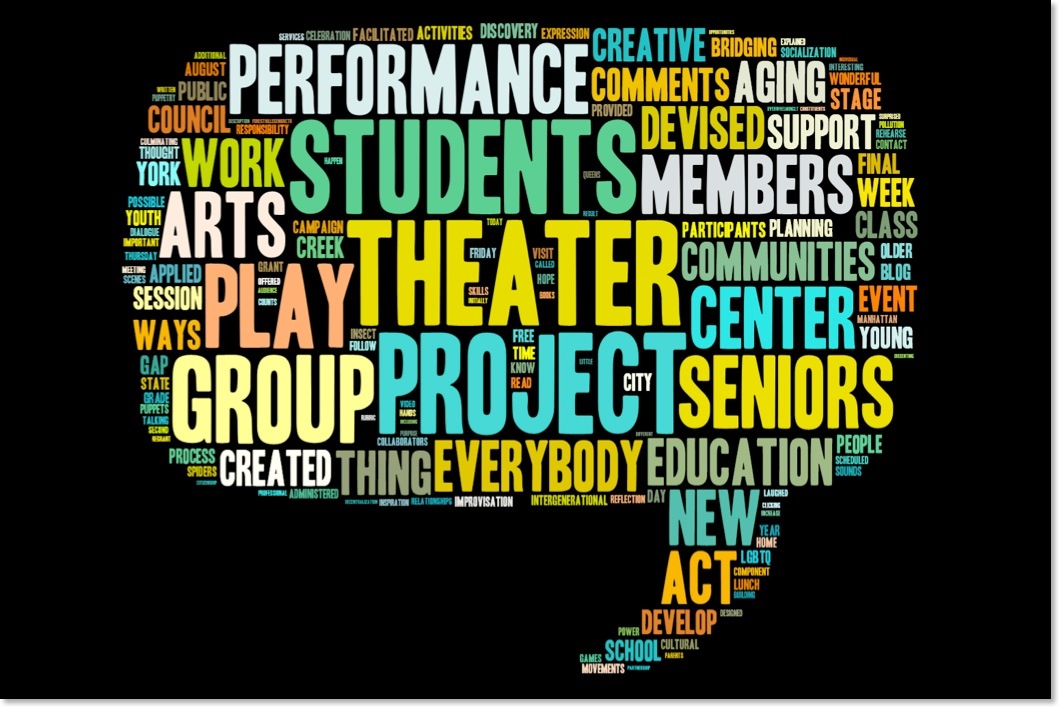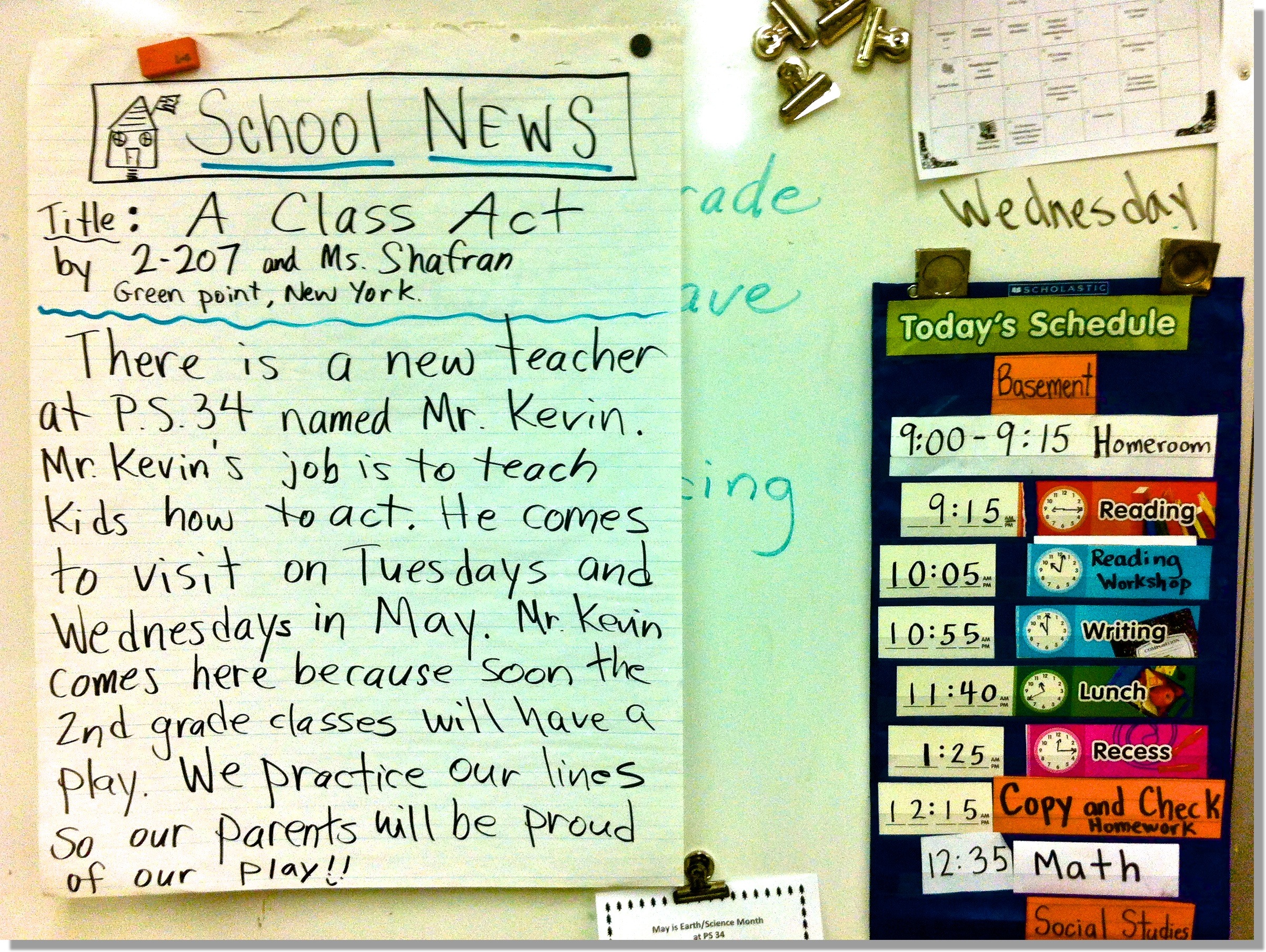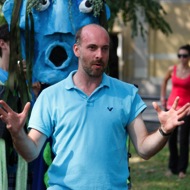From The Director's Desk
Words, Words, Words: 2012 In Review Via Word Cloud
Monday, December 31, 2012
 by Kevin Ray
by Kevin Ray Writing A Useful Year in Review
As 2012 comes to a close, I decided to write a year in review for Everybody Act! I thought it would be a great way give everyone an inside look at the arts-in-education projects and the community-based projects that happened in 2012. I also thought it would be an opportunity to reflect on the work that was done this year and, if structured well, might be useful in revealing areas of growth for the work and the blog in 2013.
Read More...
Comments
2011-12 School Year in Review & Discoveries in Practice
Friday, June 22, 2012
Everybody Act!’s debut year was a hit! The company provided arts-in-education programs at two schools in New York City: PS 34 in Greenpoint, Brooklyn and PS 144 in Forest Hills, Queens. Both programs culminated in a final performance of original plays performed by the students for parents and faculty. Here are some snapshots of what each school worked on and some discoveries I made as a result of the work.
Project Description
At PS 34, I worked with second grade students and teachers on a theater program I developed called Character Counts! On Stage and Off. I collaborated with the teachers to develop and facilitate an arts integrated program in Theater, English Language Arts, and Character Education for three classes. The program expanded on the school’s existing “Reader’s Theater” and “Character Counts!” Programs by adapting three books by Brooklyn based children’s author Michelle Knudsen into three short plays. Each of Knudsen’s books highlighted a character education concept: Carl the Complainer – citizenship; Library Lion – responsibility; Argus - respect.
The program was designed to:
Discovery In Practice
As part of the program, I worked with teachers and students to develop an ongoing rubric to track the students’ success after each session. Each of the three classes had their own rubric which included assessments based on areas such as “Using Expression”, “Using Kind Words”, and “Fluency”. Both students and teachers created the make up of their own class rubric. At the end of each in-class session, I asked the students to evaluate themselves by a show of hands. I asked them a question like, “As a whole group, how do you think you did today with using expression?” Then they raised their hands for “1: No Expression, 2: Some expression, 3: A good amount of expression, or 4: The best expression we could do.” Each time, I allowed the majority to rule and I wrote up the number in the class chart. By the second session I noticed something interesting. The students where overwhelmingly giving themselves a “4” in each category, which initially disappointed me because it seemed to defeat the purpose of having the students self-evaluate. I thought, “If they’re just going to give themselves a 4 every time, what’s the use of doing this?” However, I began to notice that there was always one or two students who disagreed with the majority of “4” givers. So one day I asked a dissenting student, “Why do you say 3?” Her response was incredibly accurate and truthful. So much so that she swayed the majority into understanding why they all should give themselves a more appropriate evaluation. I continued this practice of calling on the dissenters in each class and found that they were always able to clearly articulate their reasoning. It really showed me the power of truthfulness, bravery and the ability of an individual to influence a group.
Project Description
At PS 144, I worked with first grade students and teachers on a playbuilding program called Insects & Spiders On Stage! While I had initially proposed working on classic fairy tales, the teachers suggested incorporating a science curriculum tie in at our planning meeting. I’m always excited when teachers come to a planning meeting with interesting ideas; and while I had done A LOT of homework to be ready to work on fairy tales, I was more than willing to go in a new direction. To paraphrase director Peter Brook, “you do the preparation to throw it out!”
The first grade students were doing a unit on insects so we decided to use Eric Carle’s books such as The Grouchy Ladybug and The Very Busy Spider as our starting points. Each class of the five first grade classes focused on a different book by Carle and through playbuilding techniques such as tableaux, thought-tracking, and creative sound and movement activities, we devised five original performances, each about five to seven minutes in length. The plays incorporated different music elements. In our adaptation of The Honeybee and the Robber, the students, in role as bees, created a dance to Perez Prado’s Cuban arrangement of “The Flight of the Bumble Bee.” As part of The Very Lonely Firefly, first grade teacher Ms. Devine played guitar and wrote an original firefly song with the students. Finally, our version of The Very Busy Spider incorporated a processional style spider puppet operated by nine students!
The program was made possible by the generosity of the Parents’ Association of PS 144.
Discovery in Practice
As I was watching the students perform for their parents and teachers during the culminating event, I was struck by how tickled the audience was whenever the students used sound and movement to bring their insect and animal characters to life on stage. When six students playing mosquitoes entered the stage making high-pitched noises and flapping their arms as wings, the audience laughed raucously. As part of our improvisation during an in-class session, the students performing The Grouchy Ladybug came up with the idea to have the snake (played by five students joined together with their hands on their shoulders) enter singing and dancing “Conga-Line” style. This also received a great reaction form the audience. These sounds and movements created by the students helped me see that theatricality is just as important as dialogue - for elementary students, maybe even more so because projecting their voices in a cavernous auditorium is very challenging – even for adults! The insect and animal sounds and movements they created were so vividly executed that they told the story in a way that enhanced the dialogue. It made me wonder about using less dialogue in the future and finding more ways for young students to tell stories on stage through sounds and movements.
So that’s the year in review. I hope that it gave you a little insight into the work going on at Everybody Act! I also hope that my discoveries in practice will support you in your own work as you begin to plan for the 2012-13 school year.
Have a great summer!

Kevin
PS 34 Oliver H. Perry Elementary School | Brooklyn, NY
Project Description
At PS 34, I worked with second grade students and teachers on a theater program I developed called Character Counts! On Stage and Off. I collaborated with the teachers to develop and facilitate an arts integrated program in Theater, English Language Arts, and Character Education for three classes. The program expanded on the school’s existing “Reader’s Theater” and “Character Counts!” Programs by adapting three books by Brooklyn based children’s author Michelle Knudsen into three short plays. Each of Knudsen’s books highlighted a character education concept: Carl the Complainer – citizenship; Library Lion – responsibility; Argus - respect.
The program was designed to:
- Increase language acquisition in English language learners
- Stimulate interest among second grade students in independent reading
- Reinforce NYS Learning Standards for ELA and the Arts
- Deepen students’ understanding of character education concepts (e.g. citizenship, respect, responsibility, caring, fairness, trustworthiness) and the ways in which students can employ these concepts in their real lives
• Increase students’ self-confidence as a result of participating in a successful performance
Discovery In Practice
As part of the program, I worked with teachers and students to develop an ongoing rubric to track the students’ success after each session. Each of the three classes had their own rubric which included assessments based on areas such as “Using Expression”, “Using Kind Words”, and “Fluency”. Both students and teachers created the make up of their own class rubric. At the end of each in-class session, I asked the students to evaluate themselves by a show of hands. I asked them a question like, “As a whole group, how do you think you did today with using expression?” Then they raised their hands for “1: No Expression, 2: Some expression, 3: A good amount of expression, or 4: The best expression we could do.” Each time, I allowed the majority to rule and I wrote up the number in the class chart. By the second session I noticed something interesting. The students where overwhelmingly giving themselves a “4” in each category, which initially disappointed me because it seemed to defeat the purpose of having the students self-evaluate. I thought, “If they’re just going to give themselves a 4 every time, what’s the use of doing this?” However, I began to notice that there was always one or two students who disagreed with the majority of “4” givers. So one day I asked a dissenting student, “Why do you say 3?” Her response was incredibly accurate and truthful. So much so that she swayed the majority into understanding why they all should give themselves a more appropriate evaluation. I continued this practice of calling on the dissenters in each class and found that they were always able to clearly articulate their reasoning. It really showed me the power of truthfulness, bravery and the ability of an individual to influence a group.
PS 144 Col Jeromus Remsen | Forest Hills, NY
Project Description
At PS 144, I worked with first grade students and teachers on a playbuilding program called Insects & Spiders On Stage! While I had initially proposed working on classic fairy tales, the teachers suggested incorporating a science curriculum tie in at our planning meeting. I’m always excited when teachers come to a planning meeting with interesting ideas; and while I had done A LOT of homework to be ready to work on fairy tales, I was more than willing to go in a new direction. To paraphrase director Peter Brook, “you do the preparation to throw it out!”
The first grade students were doing a unit on insects so we decided to use Eric Carle’s books such as The Grouchy Ladybug and The Very Busy Spider as our starting points. Each class of the five first grade classes focused on a different book by Carle and through playbuilding techniques such as tableaux, thought-tracking, and creative sound and movement activities, we devised five original performances, each about five to seven minutes in length. The plays incorporated different music elements. In our adaptation of The Honeybee and the Robber, the students, in role as bees, created a dance to Perez Prado’s Cuban arrangement of “The Flight of the Bumble Bee.” As part of The Very Lonely Firefly, first grade teacher Ms. Devine played guitar and wrote an original firefly song with the students. Finally, our version of The Very Busy Spider incorporated a processional style spider puppet operated by nine students!
The program was made possible by the generosity of the Parents’ Association of PS 144.
Discovery in Practice
As I was watching the students perform for their parents and teachers during the culminating event, I was struck by how tickled the audience was whenever the students used sound and movement to bring their insect and animal characters to life on stage. When six students playing mosquitoes entered the stage making high-pitched noises and flapping their arms as wings, the audience laughed raucously. As part of our improvisation during an in-class session, the students performing The Grouchy Ladybug came up with the idea to have the snake (played by five students joined together with their hands on their shoulders) enter singing and dancing “Conga-Line” style. This also received a great reaction form the audience. These sounds and movements created by the students helped me see that theatricality is just as important as dialogue - for elementary students, maybe even more so because projecting their voices in a cavernous auditorium is very challenging – even for adults! The insect and animal sounds and movements they created were so vividly executed that they told the story in a way that enhanced the dialogue. It made me wonder about using less dialogue in the future and finding more ways for young students to tell stories on stage through sounds and movements.
Conclusion
So that’s the year in review. I hope that it gave you a little insight into the work going on at Everybody Act! I also hope that my discoveries in practice will support you in your own work as you begin to plan for the 2012-13 school year.
Have a great summer!

Kevin
From The Director's Desk
Friday, September 23, 2011
 Hello!
Hello!My name is Kevin Ray and I am the Executive Director and Founder of Everybody Act! Theater in Education & Communities.
I am thrilled to announce that Everybody Act! is a new face on the arts services provider scene and I look forward to developing creative opportunities with new partners. I chose the name Everybody Act! because it perfectly frames the dual purposes of my core beliefs when using theater with youth and community members: I believe that everybody can learn performance skills to act on stage and that everybody can take action in their daily lives in response to what they have created on stage. Read More...

